|
Don't mess with Texas. On the bus ride over, the lovely Texas Hill Country was a special treat. |
My observing setup. The cameras (from left to right) are named, "new Ringo," "John," and "Jimi." As always, Jimi was wailing. |
Unfortunately, the weather was cloudy. It could have been worse: it could have been raining. |
|
The intrepid eclipse chasers soldier on, regardless of the weather. |
Going, going... During the partial phases, the Moon only partly obscures the Sun. |
Totality! The solar corona, which is hot gas escaping from the Sun, is visible through thin clouds. |
|
This totality was the darkest I had ever seen. It was as dark as night: usually totality is an eerie twilight. Venus briefly become visible through the clouds, as a point of light to right of the eclipsed Sun. |
It's good to see the eclipse chasers getting their money's worth. We could hear crickets chirping |
Prominences are magnetically heated, buoyant loops and streamers of gas rising from the Sun. Multiple prominences were visible, but the clouds allowed me a shot of only this one, on the Sun's south limb. |
|
My fearless girlfriend, the one-and-only Anne C. Smith , marvels at the wonders of totality. |
Diamond ring! The bright solar surface (also called the photosphere) emerges, signaling the end of totality. |
The lovely Texas Hill Country was a treat on the bus ride home, too. |
The Total Solar Eclipse of 2017 August 21 PDT,
observed from the
backyard of
Sweet
Virginia's Bed & Breakfast hotel, Metolius, Oregon
This soundtrack is an 8.41-MB, WAV-format audio file, which can be played on Windows Media Player.
It was recorded during totality by F. Ringwald. Here is a version with animation and music added by Dr. Mel Helm.
|
Tryna (in back), Gail, and Anne in back of Sweet Virginia's, snapshot with a Canon PowerShot SX120IS 10MP digital camera by F. Ringwald. |
"The ground's in tip-top condition, and I think we can expect some first-rate eclipsing this morning..." (Eric Idle), snapshot with a Canon PowerShot SX120IS 10MP digital camera by F. Ringwald |
My observing setup, snapshot with a Canon PowerShot SX120IS 10MP digital camera by F. Ringwald. The cameras are named, "John," "Paul," "George," and "Ringo," and "Janis" and "Jimi." As always, Jimi was wailing. |
|
Eclipse crescents, which are shadows under a tree, on the garage of Sweet Virginia's and first noticed by Mel Helm, snapshot with a Canon PowerShot SX120IS 10MP digital camera by F. Ringwald |
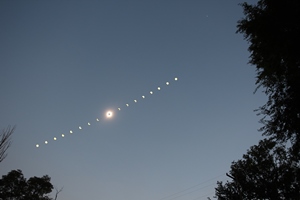 Wide-field composite, with partial phases shown on a background taken during totality. Full-color image taken with a Canon T5 Rebel DSLR camera (camera "George") at ISO 200 through a Rokinon 16M-C 16mm f/2.0 Aspherical Wide-Angle Lens, with an exposure time of 0.3s (set by the camera) during totality, and of 30s and through a Thousand Oaks solar filter during the partial phases, by F. Ringwald |
Going, going... Full-color image taken with a Canon EOS 60Da astrophotography DSLR camera (camera "Jimi") at ISO 200 with an exposure time of 1/8000s through a Canon EF 400mm f/5.6L USM Super Telephoto Lens by F. Ringwald |
|
Bailey's beads are the last traces of the Sun's surface visible between the rims of lunar craters. Full-color image taken with a Canon EOS 60Da astrophotography DSLR camera (camera "Jimi") at ISO 200 with an exposure time of 1/8000s through a Canon EF 400mm f/5.6L USM Super Telephoto Lens by F. Ringwald |
The last Bailey's bead isn't the same as a "diamond ring.' Full-color image taken with a Canon EOS 60Da astrophotography DSLR camera (camera "Jimi") at ISO 200 with an exposure time of 1/8000s through a Canon EF 400mm f/5.6L USM Super Telephoto Lens by F. Ringwald |
The solar chromosphere is the atmosphere of the Sun. Full-color image taken with a Canon EOS 60Da astrophotography DSLR camera (camera "Jimi") at ISO 200 with an exposure time of 1/8000s through a Canon EF 400mm f/5.6L USM Super Telephoto Lens by F. Ringwald |
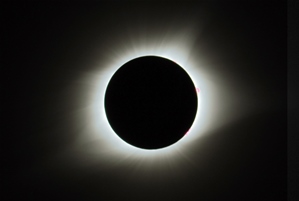 The total solar eclipse of 2017 August 21, composite of full-color images taken with a Canon EOS 60Da astrophotography DSLR camera (called "Jimi") at ISO 200 with exposure times between 1/13s and 1/2500s through a Canon EF 400mm f/5.6L USM Super Telephoto Lens by F. Ringwald |
Solar prominences are loops or streamers of hot, buoyant gas rising from the Sun. Full-color image taken with a Canon EOS 60Da astrophotography DSLR camera (called "Jimi") at ISO 200 with an exposure time of 1/2500s through a Canon EF 400mm f/5.6L USM Super Telephoto Lens by F. Ringwald |
Totality through a fisheye lens, full-color image taken with a Canon EOS 5D Mark II DSLR camera (modified for astrophotography by Hutech) (camera "Paul") at ISO 200 with an exposure time of 0.3s (set automatically by the camera) through a Canon 15mm f/2.8 fisheye lens by F. Ringwald |
|
|
We saw it! Snapshot with a Canon PowerShot SX120IS 10MP digital camera by F. Ringwald |
|
The Total Lunar Eclipse of 2015 September 27 PDT,
observed from
across San Ramon Avenue from the Downing Planetarium,
California State University, Fresno
 Lunar eclipse sequence of full-color images taken with a Canon EOS 60Da astrophotography DSLR camera at ISO 1600 with exposure times between 1.6s and 1/640s through a Canon EF 400mm f/5.6L USM Super Telephoto Lens by F. Ringwald |
The Partial Solar Eclipse of 2014 October 23 PDT,
observed from the
Downing Planetarium,
California State University, Fresno
 Partial solar eclipse sequence, of Registax stacks of 300 x 1/12-s Orion Starshoot III exposures through a Coronado Ca K (70mm, f/5.7, 0.22nm bandpass centered at 393.4nm) solar telescope by Simon Gonzalez.
The Total Lunar Eclipse of 2014 April 14-15 PDT,
|
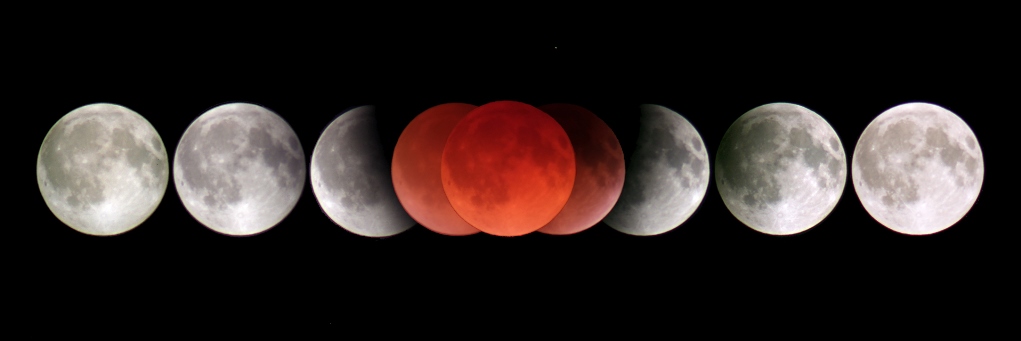 Lunar eclipse sequence of full-color images taken with a Canon EOS 60Da astrophotography DSLR camera at ISO 100 with exposure times between 1/800s and 8s through the Orion ShortTube 80mm refractor guidescope at f/5 by F. Ringwald |
The Partial Lunar Eclipse of 2012 June 4 PDT,
observed from a balcony
of McLane Hall at Fresno State
|
Patial lunar eclipse of 2012 June 4, full-color image taken with a Canon EOS 20Da astrophotography DSLR camera at ISO 200 with a 1/400-s exposure time through an EF 100-400mm f/4.5-5.6L IS USM lens with f=400mm at f/5.6 by F. Ringwald |
The Annular Solar Eclipse of 2012 May 20,
Whiskeytown Lake, California
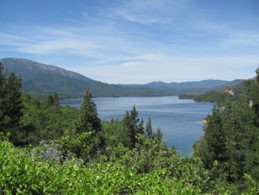 Whiskeytown Lake, near Redding, CA, snapshot by F. Ringwald |
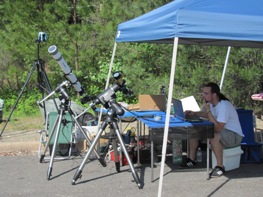 Our setup, with Fresno State physics graduate student Dillon Trelawny observing, snapshot by F. Ringwald |
 CaK Annular eclipse sequence. This is series of full-color Registax stacks of Orion Starshoot III exposures through a Coronado Ca K (70mm, f/5.7, 0.22nm bandpass centered at 393.4nm) solar telescope and wavelet processed by Dillon Trelawny. |
 Annular eclipse sequence. This is series of exposures through an Orion 90mm f/10 refractor and Thousand Oaks Type 2+ white light solar filter with a Canon EOS 60Da camera at ISO 100, each image being a single 1/13 to 1/80-s exposure, by F. Ringwald. |
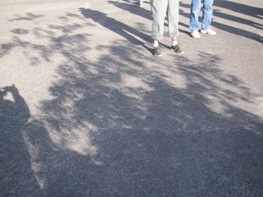 Crescent shadows under a tree, snapshot by F. Ringwald |
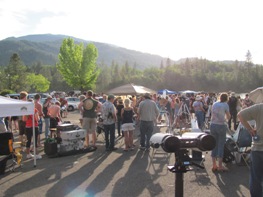 Eclipse crowd of about 2000, snapshot by F. Ringwald |
The Lunar Eclipse of 2003 May 15,
observed from the Downing
Planetarium, California State University, Fresno
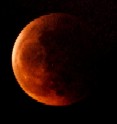 Lunar eclipse in totality, 2003 May 15. This is a 1/15-s exposure on 800-speed Fujicolor Superia X-Tra film, through a 90mm refractor at f/10 by F. Ringwald. |
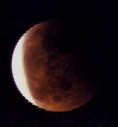 Lunar eclipse emerging from totality, 2003 May 15. This is a 1/15-s exposure about an hour after the previous one, by F. Ringwald. |
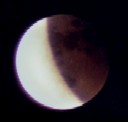 Lunar eclipse after totality, 2003 May 15. This 1/8-s exposure was taken about an hour after the previous one, by F. Ringwald. |
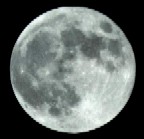 Full Moon, taken about an hour after the end of the lunar eclipse, 2003 May 15. This is a 1.0-s exposure on 100-speed TMax film, through a 90mm refractor at f/10, by F. Ringwald. |
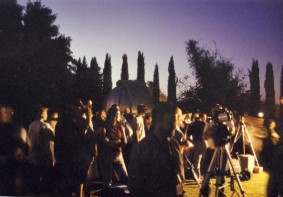 Lunar eclipse crowd, 2003 May 15. This is a 1/15-s exposure on 800-speed Fujicolor Superia X-Tra film, through a 50mm lens at f/3.5 by F. Ringwald. |
Click here to go to the Moon Gallery
Click here to go to the Main Gallery
Last updated 2024 April 26. Web page by Professor Ringwald (ringwald[at]csufresno.edu and replace [at] with @)
Department of Physics, California State University, Fresno. Please read this disclaimer.